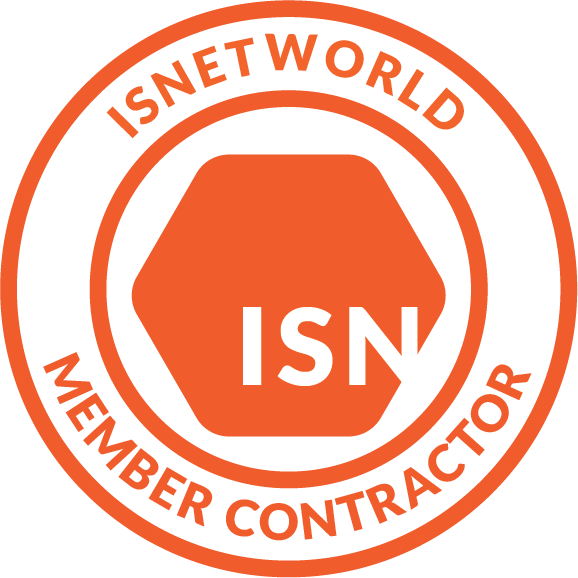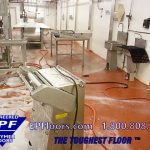CLEANING GUIDE:
How to Clean 300/400 Series PumaCRETE Processing Floors
How to Clean 300/400 Series PumaCRETE Processing Floors
Description of PumaCRETE 300/400 Series Flooring
PumaCRETE 300/400 series floors are cementitious urethane, which are hard, impervious, non-absorbent and non-dusting. This ensures not only their durability, but ease of cleaning when a suitable cleaning program is used. The cleaning and maintenance of a PumaCRETE floor must be considered a vital and integral part of an overall hygiene program covering all parts of a processing plant. With this guide, we hope to explain how to clean urethane floors and surfaces. All PumaCRETE floors have proved to be both cleanable and sanitizable with regard to micro-organisms, and do not support the growth of bacteria.

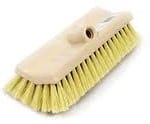

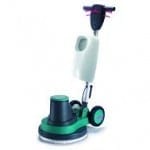
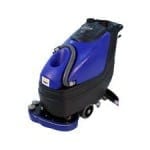
PumaCRETE 401-HF
401-HF Urethane Concrete mortar floors are applied as a one-pass system; these floors are the “work horse” of our product line, and are designed for maximum durability. These floors may have either a light or aggressive sand texture. The sand finish is only temporary, which gives the floor temporary non-slip, until the floor “wears-in”. Once the floor “wears-in”, the large stone aggregate within the floor provides a permanent non-slip surface, which cannot wear off.
PumaCRETE 301-SL/SLB
300 Series cementitious urethane floors have a higher gloss, and are more impervious to marking and staining, than our 400 series; these are applied in two layers: the base layer, which has a layer of broadcasted sand; and a lockcoat of sealer, which seals/locks the broadcasted silica, and provides a more cleanable texture. This system provides a slip-resistant surface, along with a glossy, stain-resistant finish.

CURING TIME:
Full cure for heavy traffic on urethane floors:
Regular Systems: 24 hours at 70 deg F.
Fast curing Polyaspartic top coat option: 4 hours cure cure at 70 deg F.
Note: The lower the room temperature, the longer the cure time.
Post Installation
Use of non-marking lift truck tires are highly recommended, in order to prevent black tire marks, embedded into the new floor. Black tire marks may be removed with a good cleaner; however they require a great deal of cleaning to remove, once embedded into the finish.
Immediately following new floor installation. Puma-Crete floors may be subjected to types of usage, which are very different from those expected during normal service, such as:
- Heavy lifting equipment (forklifts, etc.)
- Movement of heavy, cumbersome equipment.
- Spillage of paints, mastics, and sealants from other contractors/maintenance.
Because of this, it is important to consider using one of the following:
- The installation of temporary covers of a plastic material; for example, polyethylene sheeting and 3/16” hardboard (Masonite). if other trades are to work in the area, tape the seams.
- Covering the area to be subjected to traffic and additional trades with plywood sheets with heavy duty tape at the seams.
- The avoidance of early heavy usage, particularly with rubber-wheeled vehicles. This will minimize the risk of dirt being embedded into the surface of the floor, before it reaches full hardness.
Note: A period of 48 hours is advised at lower temperatures before full service is permitted.
INITIAL URETHANE CLEANING:
When cleaning the floor prior to its being put into its intended service, more aggressive cleaning chemicals than normal may be used. These will not damage the floor, but the use of strippers/cleaners containing caustic alkalis and chlorinated hydrocarbon solvents should be avoided as they can bleach and discolor the floor surface.
* Specialty heavy duty cleaners are available. Contact E P Floors Corp. for more information.
IN-USE CLEANING
Specialized floor cleaning equipment is widely available, as the variety of cleaning chemicals and bactericides/sterilants used with it. Your choice of a Puma-Crete 300 or 400 series floor does not restrict your choice of cleaning regime, equipment or chemicals.
Floor Cleaning Equipment
- Broom or dust mop
- Mop/Bucket (note: Never use a mop to clean a floor that is greasy or oily).
- Soft Neoprene Rubber Squeegee
- Deck Brush: medium to firm, plastic bristle
- Rotary Floor Machine: Brushes should be nylon non-abrasive medium flex bristle brush.
- Hi Pressure Water Hose: rinsedown
- Wet Vac or Automatic Floor Scrubber: vacuum up water, if drain not available
When selecting equipment consider the following criteria:
- Relate the method to the “soil” type; what is suitable for wet “soil” in a meat preparation area may not be suitable for dry “soil” in a bakery.
- Relate the method, and frequency, of cleaning to the risk status of the area; all methods may be suitable in a finished goods warehouse but not in a high risk area such as chilled-food preparation.
- Methods suitable outside of production hours may not be appropriate during production; be aware of the risk of aerosol generation.
Urethane Cleaning-equipment manufacturers have specialized knowledge, and offer practical demonstrations of equipment. You are advised to consult them. The list below is not exhaustive but it’s provided as a guide. (Similar equipment from other manufacturers may be equally suitable).
Advance/Nilfisk, Tennant Co., Hoover, Henkel, Ecolab, Electrolux Equipment Supplies
Cleaners
Including bactericides: the variety of cleaning chemicals and bactericides/sterilants available is extensive, and making the appropriate selections can be confusing. The correct choice of chemicals is important and you are strongly advised to seek specialist advice. The following companies will be able to offer advice on the selection of appropriate cleaning chemicals in relation to “soil” types including the removal of unsightly rubber tire marking. The listing is by no means complete and consultation with other reputable suppliers is recommended.
Ecolab, Zep, Delta, Tennant Co * Specialty heavy duty cleaners are also available from EP Floors Corp.
Maintenance & Repair
Even the most meticulously-cleaned PumaCRETE floor may suffer damage to its integrity by some unforeseen incident in the workplace, which could result in a consequential risk of bacteriological build-up in cracks etc. If this situation arises, the damaged floor should be repaired without delay. You may consult our technical support department, which has the in-depth knowledge of the remedial techniques that will restore your 300/400 series urethane floor to its original condition.
We stock repair kits, if needed, which may be used to easily perform minor repairs.
Safety Note:
No matter how aggressive the texture of your floor, if it is not cleaned properly, it can present a slip hazard. Emulsifying and rinsing your floor properly will reduce the risk of a slip and fall incident.
IN-USE CLEANING
Specialized floor cleaning equipment is a widely available, as is a variety of cleaning chemicals and bactericides/sterilants used with it. Your choice of a HF or HFB urethane floor does not restrict your choice of cleaning regime, equipment or chemicals. If surface has ground-in stains/marks: first, apply cleaning chemicals to floor; allow to “soak in” emulsify and lift the “soil” from the floor. Next, scrub with soft to medium nylon/polypropylene bristle brush (manual or machine).
Floor Cleaning Equipment:
- Broom or dust mop (smooth floors)
- Mop/Bucket note: Never use a mop to clean a floor that is greasy or oily.
- Soft Neoprene Rubber Squeegee
- Deck Brush: medium to firm, angled nylon plastic bristle
- Rotary Floor Machine: Brushes should be nylon/polypropylene non-abrasive medium flex bristle brush.
- Hi Pressure Water Hose: rinsedown
- Wet Vac or Automatic Floor Scrubber
When selecting equipment consider the following criteria:
- Relate the method to the “soil” type; what is suitable for wet “soil” in a meat preparation area may not be suitable for dry “soil” in a bakery.
- Relate the method, and frequency, of cleaning to the risk status of the area; all methods may be suitable in a finished goods warehouse but not in a high risk area such as chilled-food preparation.
- Methods suitable outside of production hours may not be appropriate during production; be aware of the risk of aerosol generation.
Most cleaning-equipment manufacturers have specialized knowledge, and offer practical demonstrations of equipment. You are advised to consult them. The list below is not exhaustive but it’s provided as a guide. (Similar equipment from other manufacturers may be equally suitable). Advance/Nilfisk, Hoover, Ecolab, Electrolux Equipment Supplies, Tomcat Equipment Co.
Cleaners
Including bactericides: the variety of cleaning chemicals and bactericides/sterilants available is extensive, and making the appropriate selections can be confusing. The correct choice of chemicals is important and you are strongly advised to seek specialist advice. The following companies will be able to offer advice on the selection of appropriate cleaning chemicals in relation to “soil” types including the removal of unsightly rubber tire marking. The listing is by no means complete and consultation with other reputable suppliers is recommended. Ecolab, Zep, Delta. Specialty heavy duty cleaners are also available from EPF.
Maintenance & Repair
Even the most meticulously-cleaned HF & HFB urethane floor may suffer damage to its integrity by some unforeseen incident in the workplace, which could result in a consequential risk of bacteriological build-up in cracks etc. If this situation arises, the damaged HF and HFB Urethane floor should be repaired without delay. You may consult our technical support department, which has the in-depth knowledge of the remedial techniques that will restore your HF or HFB urethane floor to its original condition.
*We also stock repair kits, if needed, which may be used to easily perform minor repairs.
Safety Note: No matter how aggressive the texture of your floor, if it is not cleaned properly, it can present a slip hazard. Emulsifying and rinsing your floor properly will reduce the risk of a slip and fall incident.

